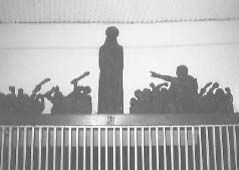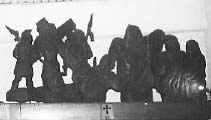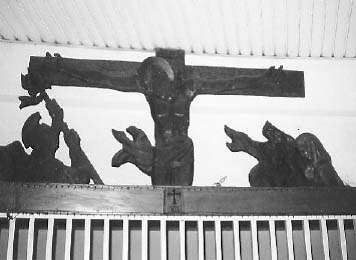Abueva's narra sculpture of the Stations of the Cross befits
a cathedral
If you stand near the altar in the center aisle and look toward
the back, you will see the Abueva sculptures of the Stations of
the Cross, right above the whole span of the floor-to-ceiling
windows _ "Abueva" sculptures because they were executed
by Napoleon Abueva, National Artist for Sculpture and Professor
at the University of the Philippines.
Viewed from this perspective, the Abueva wood sculpture of the
Stations of the Cross consisting of 14 panels presents a moving
tableau of the passion, death and resurrection of Jesus.
The panels for each Station are immense by all standards! The
2nd Station is the smallest (5 feet in height &
8 feet wide) while the 14th Station is huge (5 feet
tall and 15 feet wide)!
Nowhere in the Philippines can you find such colossal wood-carved
Stations of the Cross installed inside a church.
Only at the Immaculate Heart of Mary Parish!
* * * * *
Carved from the finest Philippine narra, the `Stations of
the Cross' is the first and only one of its kind of such magnitude
that Abueva sculpted for a church interior.
 1st
Station: Jesus is Condemned to Death 1st
Station: Jesus is Condemned to Death
The 14 Stations of the Cross which are ensconced in the alcoves
or niches between the beams of the church roof consist of 35 narra
woodcarvings about 8-12 inches thick. The smallest piece is 4-square
feet while the largest, is 75 a square feet wood block depicting
the 14th Station.
You have to view Abueva's '14 Stations' at close range to better
appreciate his technique of visualizing the passion; death and
resurrection of Jesus.
 Notice
for example how the 4th and 11th Stations
depict views from the top as if the viewer is looking down from
a high window! Notice
for example how the 4th and 11th Stations
depict views from the top as if the viewer is looking down from
a high window!
Take special notice of the 4th Station;
see how this top view makes the hands of the grieving women stand
out! You can feel the compassion in their outstretched arms!
4th Station: Jesus meets His Mother (top view)

11th Station: Jesus is nailed to the cross (top view)
In 1996, an official of the National Commission of Culture and
the Arts (NCCA) on seeing Abueva's work exclaimed in great awe:
"My God, this is a magnificent work of art, a priceless
`obra maestra' that befits a athedral!"
President Gloria Macapagal-Arroyo was likewise overwhelmed by
the Abueva sculpture when she heard Mass at the IHMP Church on
May 25 in connection with the 2003 Fiesta Celebration.
Now it can be told!
The Abueva sculpture was donated to the IHMP by Colonel
and Mrs. Pio Caluya.
This is confirmed by Sis. Josie Fonacier who brokered the donation!
For the past 22 years the identity of the couple was a tightly
guarded secret as the Caluyas desired to be known only as "Mr.
& Mrs. Anonymous" to safeguard their privacy..
 Station 8: Jesus consoles the women of Jerusalem Station 8: Jesus consoles the women of Jerusalem
"The idea of having a wood-sculptured `stations of the
cross' was Fr. Blanco's", Sis. Josie revealed to me, saying:
"Fr. Blanco wanted these to complement the three wooden altar
pieces by Spanish Claretian sculptor, Fr.Segundo Gutierrez"
Sis. Josie said she volunteered to contact UP Prof. Abueva.
Both of them were teaching at UP Diliman, he at Fine Arts and
she at the Science Education Center.
"After the start of classes in 1980, I met Billy Abueva
at the UP Faculty Center. He was then the Dean of the College
of Fine Arts," Sis. Josie recounts," I broached to him
the idea of sculpting the Stations of the Cross in wood for IHMP."
And he replied "Yes, why not?" 
"It was just as simple as that!" says Sis. Josie.
According to Sis. Josie Fonacier, it took Prof. Napoleon Abueva
more than a year to finish work on the Stations of the Cross.
"The rest is history," Sis. Josie concludes.
Station 9: Jesus falls the third time
In September 1981, this Abueva work was blessed by Manila Archbishop
Jaime `Cardinal' Sin, with former First Lady Leonila Garcia as
Special Guest!

Station 12: Jesus dies on the cross
Shortly before the blessing, the Deed of Donation of this Abueva
sculpture was signed between the donors, Colonel and Mrs. Pio
Caluya and the then parish priest, Rev. Fr. Ignacio Blanco, who
accepted the donation in behalf of the Immaculate Heart of Mary
Parish.
The Caluya deed of donation prohibits the IHMP from selling
or disposing the Abueva sculpture in any manner, otherwise the
`same shall revert back to the donor".
|